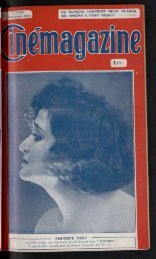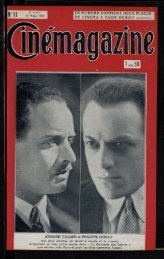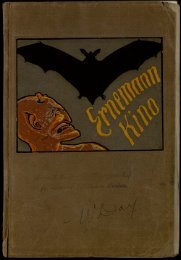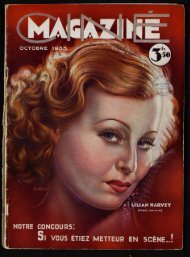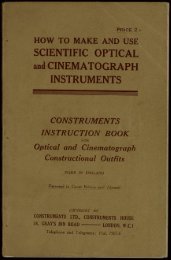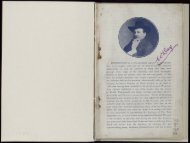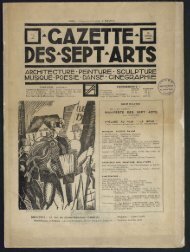Untitled
Untitled
Untitled
You also want an ePaper? Increase the reach of your titles
YUMPU automatically turns print PDFs into web optimized ePapers that Google loves.
10<br />
MODERN MAGIC LANTERNS.<br />
the oxygen nozzle is withdrawn further into the jet, or, what<br />
comes to the same thing practically, when a nozzle is fitted<br />
to the jet, as shown in Fig. 31, the mixture of the gases is<br />
effected very much better, and the light emitted from the<br />
lime is proportionately increased, but a danger,<br />
or rather an inconvenience, is experienced. If<br />
in such a jet as Fig. 31 the oxygen be turned<br />
completely off, the coal gas will to a certain<br />
extent make its way into the oxygen tube, and<br />
when that gas is turned on again the mixture<br />
in that tube will cause a slight explosion or<br />
Fig. 31.<br />
" pop, " putting out the light and startling the<br />
BLOW-THROUGH audience, although nothing more serious will<br />
JET<br />
WITH NOZZLE. result. Such an occurrence can be prevented<br />
by turning the oxygen not quite but nearly off,<br />
so that just a faint blue bead in the flame indicates that it<br />
is still passing.<br />
In this form of jet the coal gas or hydrogen is always in<br />
large excess of the oxygen, and the area of lime heated is<br />
much larger than with the mixed jet. On the other hand, a<br />
light powerful enough for everything but the largest displays<br />
can be obtained with a blow-through jet, together with an<br />
almost complete guarantee against mishap.<br />
To use the blow-through jet, the lime should be adjusted<br />
about half an inch from the gas orifice, but not clamped<br />
there, and the hydrogen lighted and turned full on. (We<br />
might mention here that the hydrogen and oxygen pipes and<br />
taps should be distinguished both by colour and by having<br />
the words OXYGEN and HYDROGEN engraved on them, or,<br />
better still, the handles of the taps should be different in<br />
shape, telling the operator by the feel alone of which he has<br />
hold.) The oxygen must now be slowly turned on until any<br />
increase in its amount ceases to cause the light to increase.<br />
When no more light can be obtained by adjustment either<br />
of the hydrogen or oxygen, the lime should be moved slightly<br />
nearer or further away from the jet until the position is<br />
found where the light is most brilliant. When this is<br />
ascertained, the holder should be clamped there once and<br />
for all. To turn the jet out, the oxygen should first be<br />
cut off, and then the hydrogen lowered.<br />
4<br />
JETS.<br />
As the jet plays upon the lime it gradually "pits "it, and<br />
the lime must from time to time be turned. Large wings of<br />
burning hydrogen should not be allowed to play each side of<br />
the lime, as such a course is wasteful, and they may be<br />
directed against the condenser and damage it ; they also<br />
help to heat the lantern unnecessarily.<br />
The mixed jet, which yields the most intense light of any,<br />
is shown in Fig. 9. As its name implies, the gases are<br />
'mixed before being burnt at the nipple, and to this end the<br />
two tubes terminate in a chamber below the nipple itself.<br />
The nature and form of this chamber have been the subject<br />
of many and careful experiments by the Rev. Hardwich,<br />
Mr. Lewis Wright, and others, and the outcome of their<br />
work has resulted in the form shown in section in Fig. 32.<br />
The chamber, which is here shown, is filled up with a series<br />
of circular discs, each alternate disc having a central hole, and<br />
the others a ring of smaller perforations, the discs being separated<br />
by rings. These discs are shown by the side of the<br />
chamber in the figure. Such a chamber ensures the gases<br />
being most thoroughly mixed, and when burnt in this condition<br />
the most intense heat and consequent light is produced.<br />
As with the blowthrough<br />
jet, the hydrogen<br />
should first be<br />
turned on and lit,<br />
then the oxygen added<br />
slowly until the<br />
best light is obtained.<br />
If the jet should roar,<br />
the gas should be<br />
regulated until it<br />
ceases to do so ; with<br />
some jets this cannot<br />
be done. In this case<br />
the roaring is a sign<br />
that the gas passage<br />
Fig. 32. MIXING CHAMBER.<br />
in the nipple is not perfectly smooth, and this is best<br />
remedied by the maker. To extinguish the jet, the oxygen<br />
is first turned off and then the coal gas, the tubes on<br />
no account being detached until the light is out. Should<br />
41



